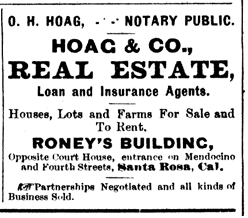
Father: Charles HOAG
Mother: Susan HAIGHT
Family 1 : Lurana Elizabeth COCKRILL
__
__|
| |__
_Charles HOAG _|
| | __
| |__|
| |__
|
|--Obadiah Haight HOAG
|
| __
| __|
| | |__
|_Susan HAIGHT _|
| __
|__|
|__
Notes:
|
Obadiah Haight Hoag is listed in the 1860 Census for Sonoma Co., CA living in Bodega Township (Smith's Ranch Post Office), living in dwelling #449, as O. H. Hogge, a 21 year old farmer born in New York, with $2000 of personal estate. Also enumerated in the same household are Elizabeth Hogge (a. 19, bp. New York, "At Home"), M. Hayes (a. 30, bp. Ireland, "Laborer"), R. Conoly (a. 30, bp. Ireland, "Laborer"), H. McGath (a. 22, bp. New York, "Laborer"), Alex Myers (a. 33, bp. New York, "Laborer"), and J. G. Hagmire (a. 40, bp. Germany, "Mill Worker"). A J. C. Hoage (a. 28, bp. New York) along with an S. Cushing (a. 22, bp. New York), which is more likely, S. Cushing Hoag, can be found enumerated in the same census for Analy Township (Sebastopol Post Office) in dwelling #246 along with a Mandivea Hoage (a female, age 17, bp. Canada) and eight other individuals. Larkin Cockrill's family is enumerated in dwelling #248. In the 1870 Census for Sonoma County, Obadiah is listed as living in Analy Township (Bloomfield Post Office), dwelling #53, as Obediah H. Hoag, a 31 year old lawyer born in New York, with $3000 of Real Estate and $1200 of personal estate. Also enumerated in the same household are Leunana E. (a. 29, bp. MO, "Keeping House"), Nettie (a. 9, bp. CA), Clement L. (a. 5, bp. CA), Cushing (a. 3, bp. CA), and None (a. 6 months, bp. CA). A Jard (?) Hoag (a. 36, bp. NY) with a woman (name unreadable) born in Canada is listed a few dwellings later on the next page of this census. In dwelling #14, there is a David Hoag (a. 24, bp. NY) along with several other Hoags of unknown relationship who were born in New York listed living in the same dwelling. According to Victoria Caldwell, a descendant of David Elmer Hoag, this David Hoag in the 1870 Census is indeed the same person as her ancestor, as well as a brother of Ella Hoag's. She believes that David is the son of Milton (O. H.'s cousin) and Abigal Adams Hoag. David had married Alice Arthur (the daughter of Charles R. Arthur) in 1872, and had two children. In the 1880 Census for Sonoma County, Obadiah is listed as living on First Street in the City of Santa Rosa, dwelling #184, as Obadiah M. Hoag, a 42 year old lawyer born in New York (both parents also listed as being born in New York), along with his wife, listed as Luranu E. (a. 39, bp. MO, father's bp. SC, mother's bp. KY). Children are listed as: Hellen O. (a. 19, bp. CA, "At Home"), Cushing E. (a. 12, bp. CA, "At School"), Obe A. (a. 10, bp. CA, "At School"), George H. (a. 8, bp. CA), Laura E. (a. 6, bp. CA), and Edith (a. 2, bp. CA).
According to an article by Gaye LeBaron, in the Santa Rosa Press Democrat, October 1, 1978, in which she interviews Aletha Hoag, the last surviving member of the family, it was said that three Hoag brothers came to California from New York around the Horn in the fifties to the gold fields and ended up in Sonoma in 1857. She mentions the name of one brother, Gerard Hoag (also known as Jared C. Hoag). He lost the election for Sonoma County Recorder and Auditor to Obadiah. O. H. Hoag and his family moved from Bloomfield to Santa Rosa in 1875 after winning this election. The other brother was known as L. Cushing Hoag. I have been unable as of yet to locate the history of his family in New York. In "Bloomfield Cemetery Records, 1864-1967" copied by Susan Appleton (Santa Rosa Annex 929.379418 Bloomfield), there is a listing for "Obadiah Haight Hoag, born in Duchess Co., N. Y. Feb. 20, 1837, died in Santa Rosa Apr. 24, 1908, came to Calif. 1857."
|
|
The "Line of Obadiah Haight Hoag" (Information from Helen Olivia Hoag, 1952), in Records of the Families of California Pioneers, DAR Collection V. 15, p. 119: |
|
Obadiah Haight Hoag was born in Milan, Dutches county, N. Y., 20 Feb. 1837, died in Santa Rosa, Calif., 25 April 1908, and was buried in Bloomfield, Calif. His father was Charles Hoag, who was born in Dutchess county 25 Dec. 1790, died there 18 June 1849, and was buried there. His mother was Susan Haight. She was born in Dutchess county 19 Oct. 1793, died there 3 Jan. 1839, and was buried there. They were married in Dutchess county 2 Nov. 1826. Charles [sic] Haight Hoag married in Valley Ford, Sonoma Co., Calif., 16 April 1860, Lurana Elizabeth Cockrill. She was born in Bates county, Mo., 3 Nov. 1840. Her father was Larkin Davenport Cockrill. He was born in Spartanburg district, S.C., 4 Jan. 1800, died in Bloomfield 12 May 1886, and was buried there. Her mother was Diadama Stamp [sic], born in Kentucky 29 Dec. 1809, died in Bloomfield in October 1886, and was buried there. They were married in Kentucky 29 Oct. 1829. The following statements are taken from the Druids' Journal of July 1895, when Obadiah Haight Hoag was Noble Grand Arc of that Order: "Mr. Hoag... is a New Yorker by birth, having first seen the light of day in the famous city of Poughkeepsie on the Hudson. After receiving a thorough education in the public schools, he entered the law offices of Tallman and Pain of Poughkeepsie... At the age of 18 years he was able to pass a most creditable examination... "He started for California... arriving here in 1857... He decided that Sonoma county was the place for him, and he was made an honored citizen of that section ever since... In 1862 (his neighbors) insisted upon his going to the capital of the State as their legislative representative... Mr. Hoag passed through the fiery ordeal of political misrule and corruption unscathed... The second time he was elected to the legislature, his opponent on the opposite ticket was his own brother, then a resident of the same village... "In 1875 Mr. Hoag was elected County Recorder and Auditor of Sonoma county, and in 1888 he was appointed Storekeeper of the Fourth Internal Revenue District, which place he filled during Cleveland's first administration... For a number of years he was extremely interested in farming enterprises in Sonoma and Monterey counties..." Larkin Davenport Cockrill was the son of Anderson Cockrill, who was born in Spartanburg district, S.C., 12 Dec. 1778, died in San Jose, Calif., 27 Oct. 1861, and was buried there. Anderson Cockrill married in North Carolina 19 Feb. 1799, Rebecca Venable. She was born in North Carolina 5 Nov. 1778, died in Salinas, Calif., in 1872, and was buried there. Larkin Davenport Cockrill went from South Carolina to Kentucky in 1804, and then on to Missouri, and settled in Bates county. He left Missouri in April 1853 with ten children in a party composed of his father and mother and his brothers and sisters and their familes. The train consisted of fourteen wagons, and droves of cattle and blooded horses, and was under the command of Col. W. B. Hagans, a brother-in-law, who was making his second trip to California. They came by ox teams over the Old Emigrant Trail across the Carson River Desert and arrived in California 5 Oct. 1853. He first taught school and was later a farmer. He was Associate Judge of Sonoma county and Justice of the Peace at Bloomfield for many years, serving up to the time of his death. He had four sons and six daughters, one of whom married Obadiah Haight Hoag. The daughters were considered the handsomest young women in Sonoma county.
Family Bible originally belonging to Charles Hoag, Dutchess county, N.Y., 1826-1926, now in the possession of Samuel T. Hoag, Pine Plains, N.Y. Personal recollections of Helen Olivia Hoag. Letter, dated Santa Rosa, 23 Feb. 1927, addressed to Mrs. H. J. Granger, Fulton, Calif., signed Helen O. Hoag (member of Santa Rosa Chapter). Cemetery and/or tombstone records, Bloomfied, Calif.
Two papers: Obadiah Haight Hoag and Larkin Davenport Hoag [?sic]. Both signed: Helen O. Hoag, Santa Rosa, 20 Feb. 1927.
Santa Rosa Chapter, Santa Rosa. Mrs. H. J. Granger, Chaplain, Chapter Chairman. Received 24 Feb. 1927. No signature of State Chairman on either paper.
Copied July 1952. |
|
His sister spelled his first name as Obadiah though it is often listed as Obediah in the public documents. O. H. Hoag is buried along with wife in the Hoag Family plot in the Bloomfield Cemetery (notice yet another spelling of O. H.'s first name).
|
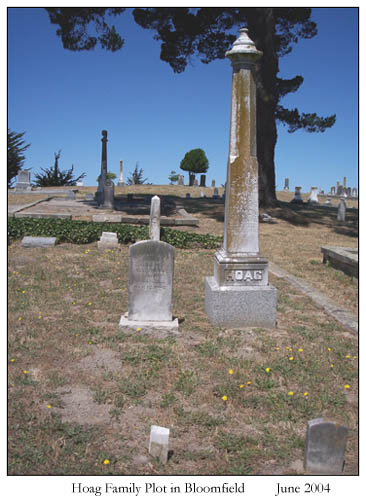
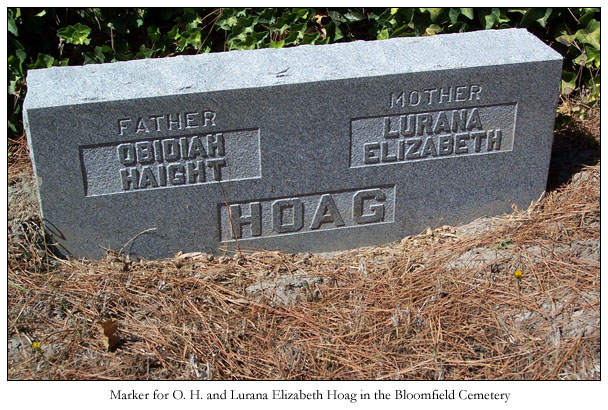
|
O. H. Hoag was an ardent supporter of the California anti-Chinese movement in the 1880s. In the 6 Mar 1886 issue of The Press Democrat there is an exchange between Obadiah and a V. Stillwell, from Bloomfield. In an article written February 23, 1886 entitled "Sweet Consistency," Stillwell accused Hoag of hypocrisy in a recent anti-Chinese speech he had given in Bloomfield, and claimed that Hoag had Chinese servants. Hoag responded in the same issue with an article entitled "Sour Consistency," and accused Stillwell of building more residences in Bloomfield for the Chinese which he describes as the ...hog-killing, opium fiend, leprous-scourged Chinamen. And that he ...nether employ Chinese nor buy their goods. Also that... the prosperous village of Bloomfield... until the advent of the "Chinese Hoards" it was valuable property, but lately is almost valueless... One wonders how he got along with his wife's cousin's family, the Fulkersons, who owned a portion of Santa Rosa's Chinatown. Obadiah had passed away a few months before the 50th wedding anniversary of S. T. and Amanda Fulkerson in 1908. It was said to have been catered by their Chinese renters.
A photograph (#11075) exists of Obadiah Hoag in the indexed photo files of the Santa Rosa Library. |
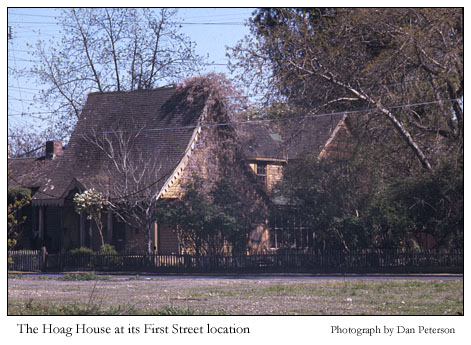
|
The Hoag family house on First Street in Santa Rosa, has had a long and complex history. My grandmother lived on Tupper Street next to Luther Burbank's garden, when she was a little girl, and like many of the other neighborhood children, she was afraid to walk down First Street (not a short distance from her house) past the creepy old Hoag House. When I went through her family papers a few years before she passed away, I noticed that she had several clippings from the Press Democrat concerning the status of the house in the 1970's and early 1980's. When I asked her about it, she said that she had received them from her cousin, Bernice (Cummins) Powers, who had also known the house as a child. However, her interest in the house was only as a childhood memory, "it has nothing to do with our family" she said. Ironically, neither she nor her cousin were aware of its connection to the Cockrills or to my grandfather's family, but knew it only as the "Witch's House," when they walked by it on their way to school as little girls in the early 1900's. It was the first wood frame building in Santa Rosa and built in 1854 in the Carpenter Gothic style of architecture, with its steeply pitched roof more commonly used back East with it's heavy winter snows rather than the more temperated Bay Area. After the destruction of the Beaver House in 1969, the Hoag House became the oldest house in Santa Rosa. Written on one of the Hoag House clippings to my grandmother, her cousin Bernice also mentions that she and her husband had also rented and lived in the Beaver House when they first got married in 1925 (still without any indication that she knew of its relationship to our family though). Most of the clippings which my grandmother had about the Hoag House were from Gaye LeBaron's Press Democrat columns. In the October 1978 column mentioned earlier, it was stated that the house was originally built by a Charlie White, a carpenter, and that the house passed through many hands before it was sold to Obediah in 1875 by James McReynolds. The sister of Lurana (Cockrill) Hoag, Obadiah's wife, Olivia, was married to James McReynolds' brother John. However, this sequence of owners differs somewhat from the extensive history and description of the house written later by Mary and Adrian Praetzellis, in The Journal of the Sonoma County Historical Society, 1985, no. 2, pp. 2-9, titled "Archaeology, History & A Hoag House Mystery". According to this essay, Obadiah entered into a lease-to-own agreement in November of 1875, with Armstead Runyon, a successful Forty-niner, for what was known as the "Wm. H. Crowell property." Runyon died in a buggy accident, and Obadiah paid the remaining half of the purchase price and obtained title in December of 1876. James McReynolds is not named in this article. The primary focus of this article was to analyze and comment on the results of a recent archaeological dig of the Hoag House site in light of Obadiah's well-known xenophobia against the Chinese. A long excerpt of this article containing more details of the house's early history is available here on this linked page. |
The house was moved to Donahue Street on June 8, 1984, but was badly damaged by fire while in the process of that move. That area was supposed to be developed as a historical housing complex. It was then moved to a field near Annadel park where for years the burned-out shell languished. According to the 1999, No. 2 issue of The Journal of the Sonoma County Historical Society, the house was to be moved to Sonoma Avenue at the south end of D. Street, adjacent to the Luther Burbank Gardens, where it was to be restored, but it never happened. Richard and Lynn Carlile presently own the remains of the structure and have led the efforts to restore it for the past fifteen years. The present plans are to have the house relocated to the Prince Gateway Park development in Santa Rosa, and the Carlile's have been collecting contributions and donations to make this possible. |
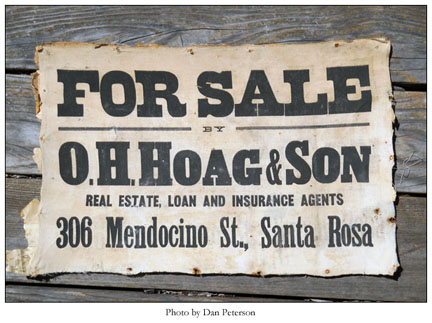
|
Unfortunately, there are issues about how the City plans to implement the Hoag's House missing and destroyed features as well as its orientation in the park area. These issues include making conjectured reconstructions which are not supported by any of the historical documentation available. What is intended at this time will misrepresent the house in a diminished way that does not reflect its unique architectural heritage. This is a sad but common story with so many buildings of historical and architectural significance. As public needs change our past becomes the victim of wholesale erasure for the most part. That which is saved is often done only as an after thought. It is often subjected to some kind of historical mutilation in the form of poor research, incorrect materials used, misunderstood styles for the times, etc. : considerations based on some modern and expedient aesthetic of what the past should have looked like back when. Fragile structures are trussed up on wheels and often moved from temporary site to temporary site like some kind of gypsy wagon. Caught in stasis by red tape and public indifference for literally years, waiting for the adequate funds and proper approvals to be restored properly, only to be damaged by time, vandals, and the decay of public and private memories. Even the best intentions can reduce a structure to its lowest denominator: a mere shadow of its original significance with no resonance or integrity to a well documented past. Indeed it is a very sad story which we have all heard too many times before. Dan Peterson fought to save the Hoag House since 1984. He was professional historical architect, member of The American Institute of Architects (AIA), and author of Santa Rosa's Architectural Heritage (Santa Rosa: Sonoma County Historical Society, 1982) and Petaluma's Architectural Heritage (Santa Rosa: Architectural Preservation Associates, 1978). His architectural firm was responsible for the relocation and restoration of the Old Santa Rosa Post Office and Federal Building (now the Sonoma County Museum), the National Register application for Railroad Square, and the restoration of a number of buildings in Railroad Square and Santa Rosa. His firm has also been involved in several other significant architectural restorations around the state, including the wonderful South Pasadena Oaklawn Bridge (designed by the Arts & Crafts masters, Henry and Charles Greene). Mr. Peterson had been in the process of drumming up more public support for the Hoag House and finally get it restored to what it once was. From an e-mail (29May2011): |
| In 1984 My wife and I acquired the Hoag House and moved it to the old City corporation yard to restore it as part of a project that included the DeTurk Round Barn. Due to problems with the City, they ultimately took back ownership of the property and someone else moved the Hoag House out to a church site where it is now. there are plans to move it back to downtown to a park called Prince Gateway Park next to Santa Rosa Creek. I think it is a great idea, except their plan is a butchered plan and does not respect the historical or architectural integrity of the building. This is where I am campaigning to get the City to do a more respectful job even to the extent of volunteering my services.
|
|
Mr. Peterson unfortunately passed away October 7, 2013 and it is not clear to me if the Hoag House has been restored according to Mr. Peterson's critical specifications. |
This page created on 02/05/01 16:08. Updated 05/31/14 08:10.